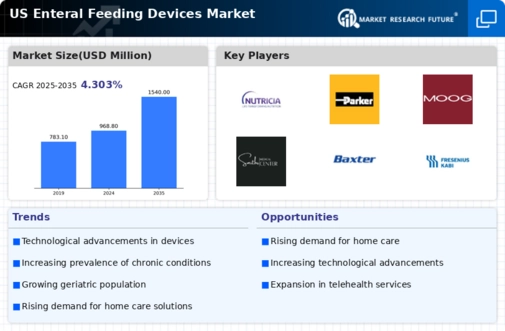The US Enteral Feeding Devices Market is characterized by a diverse range of manufacturers and suppliers that offer innovative solutions to meet the growing demand for enteral nutrition. This market is driven by an increasing prevalence of chronic diseases requiring nutritional support, such as cancer and neurodegenerative disorders, alongside an aging population. Competitive dynamics in this space are marked by advancements in technology, a focus on improving patient outcomes, and the ongoing need for efficient feeding solutions. Companies operating within this market continually invest in research and development to introduce next-generation devices that enhance usability, safety, and efficacy.
The landscape also sees various strategic partnerships, collaborations, and mergers aimed at expanding product offerings, enhancing distribution networks, and increasing market share by reaching diverse healthcare settings.
Nutricia, a key player within the US Enteral Feeding Devices Market, is known for its strong focus on providing specialized nutrition solutions. The company distinguishes itself through its broad portfolio of enteral feeding products that cater to specific clinical needs, ensuring tailored nutritional support for patients. Nutricia's strengths lie in its robust research and development capabilities, enabling the introduction of cutting-edge nutritional formulations and feeding devices. Their quality management and regulatory compliance further enhance their reputation in the sector.
With strategic partnerships with healthcare professionals and facilities, Nutricia has established a significant presence in hospital and home care settings, ensuring that patients have access to high-quality nutritional support and feeding solutions that meet their unique dietary requirements.
Parker Hannifin operates in the US Enteral Feeding Devices Market with a focus on delivering precision-engineered products that enhance the efficiency and safety of enteral feeding. The company's offerings include a range of innovative feeding tubes, pumps, and accessories designed to optimize patient care. Parker Hannifin's commitment to quality and innovation is evident in its continuous product development and strengthening market presence. Their strategic mergers and acquisitions have allowed them to enhance their product portfolio and expand their reach within the healthcare sector.
With a strong emphasis on research and engineering, Parker Hannifin stands out for its ability to provide reliable and effective enteral feeding solutions that cater to the specific needs of patients and healthcare providers. Their extensive distribution network and dedicated customer service further fortify their competitive position within the US market, ensuring that they are well-poised to meet the evolving demands of enteral nutrition.























Leave a Comment